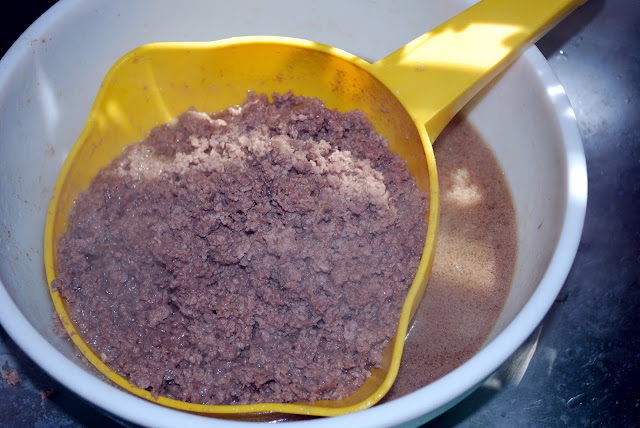
Learn how to cook ground beef by boiling instead of frying, why you should boil ground beef, and how to use boiled ground beef in this post.
Why you should boil ground beef instead of frying
A freezer emergency is what led to this post. The freezer died, and I couldn't refreeze the meat unless I cooked it first.
I pressure-canned a canner-load of the beef, and baked some meatballs and put them in the freezer, but I still had quite a few pounds that had to be dealt with.
Frying ground beef results in splattered grease all over the stove top and kitchen, but there's still a lot of fat in the cooked meat.
Boiling ground beef actually reduces the fat in the meat. You're left with leaner meat to use in your favorite recipes or to put in the freezer for a quick meal later on.
Most of the fat is left in the water after cooking, so boiled ground beef is much healthier than frying.
How to boil ground beef
Start by adding water to a large pot and bringing it to a boil. A couple of inches of water will do.
My pot is only big enough to do two pounds at a time, but if you have a large enough pot you can cook up to five pounds at once.
Crumble up the ground meat with your fingers and add it to the boiling water.

Stir the ground meat with a large spoon soon after you add it to the water.
If you want finer crumbles, stir the meat often and smoosh the pieces with your spoon. If you like bigger chunks (which would be better in chili than finely-ground meat, in my opinion), don't stir quite as often or as vigorously.

It doesn't take long for the meat to cook, but the length of time it will take depends on the temperature of your stovetop so I can't tell you how long to boil it.
You'll know when it's done: when it's no longer pink.

Straining the beef from the cooking water
Pour the contents of the cooking pot - cooked meat and water - into a strainer that's been set it over a large bowl to catch the water and fat.
Do not let the greasy water go down the drain, or pour it down your sink drain! The fat will plug up your sink pipes.
Since I was boiling several batches of ground beef, I reused the water for each batch. I just poured it back in the pot from the bowl.
Then, after I finished cooking all the meat, I refrigerated the water overnight so I could remove the layer of grease that had solidified on top of the water.
Then the water should be safe to pour down the drain (although I admit that I poured it out in the woods behind the house instead).

Packaging your cooked ground beef
You can run the strainer of ground beef under hot water to wash off any remaining fat if you wish.
To cool the meat down before freezing, let cold water run over the meat in the strainer for a few minutes.
Click here to subscribe to The Acorn, Oak Hill Homestead's weekly-ish newsletter.
Let the meat drain well on paper towels, then divide the cooked meat into meal-sized portions and package it for the freezer in freezer containers or zippered freezer bags. Or vacuum seal the cooked ground beef using a Foodsaver vacuum sealer.
A "meal-sized portion" for the two of us is about 3/4 of a pound of ground beef, which makes approximately two cups of cooked beef crumbles.
Don't forget to label the packages with the contents, amount and date. These labels will stick even in the freezer.
Kitchen tips
You can boil any kind of ground meat, not just beef. Venison, pork, bison - whatever you have.
Remember to rotate your frozen foods. You're not saving money if you're throwing food away because it's too old or freezer-burned, right? (That's why I love my Foodsaver! It really does keep food fresh longer.)
Always use the oldest package first, which is also known as "first in, first out," or FIFO.
How to use your boiled ground beef
Whether you're preparing ground beef for a future dinner, or for your dogs' food, boiling ground beef is a healthy alternative because it's lower in fat.
And having already-cooked ground beef in the freezer makes dinner so quick and easy to make.
You don't even have to thaw it ahead of time - just rinse the frozen crumbles in hot water for a few minutes before you add it to the pot of whatever you're making, whether it's chili, sloppy joes or some other delicious meal.
Make enchiladas with it, or lasagna, or add it to spaghetti sauce. The possibilities are endless.
For more frugal and self-sufficient posts like this, subscribe to my weekly-ish newsletter The Acorn, and join me on Facebook, Instagram and Pinterest.

Facebook | Pinterest | Instagram | Subscribe











